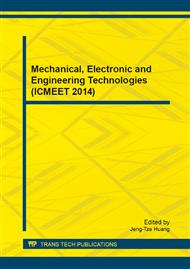p.413
p.417
p.421
p.425
p.429
p.439
p.443
p.447
p.451
Rotor Orientation Control Strategy of a Linear Arc-Shaped Induction Motor with Multiple Stators
Abstract:
This paper proposes a rotor orientation control strategy on the large proportion of gyroscopic precession of a linear arc-shaped induction motor with multiple stators, applied to maglev bearings. A physical model of the rotor, considering gravitation, is established via analysis based on rotor dynamics: the kinematic model of the rotor, which is installed vertically, can be simplified as rigid body fixed-point rotation. To complete the dynamic formula, the equivalent circuit of a linear arc-shaped induction motor is transformed into dq0 model by Park transformation, in which the decoupling control of the tangential force and the normal force is determined. Moreover, to realize the control strategy combined air-gap cross feedback with damping method, parameter identification, including no-load test and locked rotor test, is modefied. Therefore, the control strategy, aiming at controlling the speed and guaranteeing the rotor rotating vertically around its axis simultaneously, by adjusting the current of the four stators, can be proved by simulation and experimental platform.
Info:
Periodical:
Pages:
429-436
Citation:
Online since:
April 2014
Authors:
Price:
Сopyright:
© 2014 Trans Tech Publications Ltd. All Rights Reserved
Share:
Citation:


